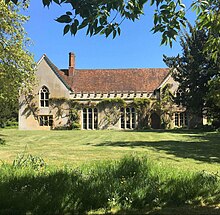Namibia International Peace Centre
The Namibia International Peace Centre was a

Winter was deported in 1972 for his opposition to South Africa's policy of apartheid. Following his expulsion from Namibia, he remained, at the request of the synod of his diocese, "bishop-in-exile", continuing to speak and write on behalf of independence for Namibia and ordaining clergy to serve there. He was known variously as Bishop of Damaraland(-in-exile) and Bishop of Namibia(-in-exile); during his exile, his eventual successor Kauluma was elected and consecrated suffragan bishop for his diocese. Newspaper publisher David Astor lent Winter The Abbey, Sutton Courtenay that originally belonged to the historic Abingdon Abbey to house the Namibia International Peace Centre.[2] In the United Kingdom, he also became noted for his anti-establishment comments, including a 1978 attack on Prime Minister Margaret Thatcher, then leader of the opposition, as ”the Iron Lady of right-wing aggression.”[3]
References
- ^ a b "Namibia International Peace Centre". africanactivist.msu.edu/. Retrieved 20 March 2020.
- ^ David Nash Ford. "The Abbey at Sutton Courtenay". Royal Berkshire History. Retrieved 20 March 2020.
- ^ "The Abbey - 800 Years of History". www.theabbey.uk.com. 2020. Retrieved 20 March 2020.
